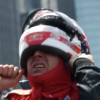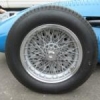I admit to not being an expert on aerodynamics. I have an engineering degree and took some basic aero course work, but that's it.
Still, I imagine this kind of rule is possible: Do whatever you want aerodynamically with the car within the following restrictions: 1) minimum ground clearance and 2) at 3 meters behind the car, in a standard wind tunnel test, the measured turbulence must be at or below this [value, pattern, distribution of forces, etc.].
The idea would be to make that turbulence a low enough number that cars are not so much disturbed by the car ahead and it becomes a limiter on what can be done with aerodynamics ahead. In a sense, it requires conditioning of the airstream as it leaves the diffuser, also.
Cornering speeds will probably drop, but races should be more exciting from an overtaking perspective, which is what I sense most people want.
I will not do much in the way of defending this 'spitball idea' because it's just that. Those of you who actually know more about this stuff may tell me that I'm asking for an impossibility (I doubt that) or would do more harm than good by slowing the cars too much compared to overtaking gains (that I can believe).
I seem to recall that there's been some discussion of this by the FIA powers that be. I suspect that teams that are heavily invested in gains from cornering speed (Red Bull) are strongly against such a rule.





































